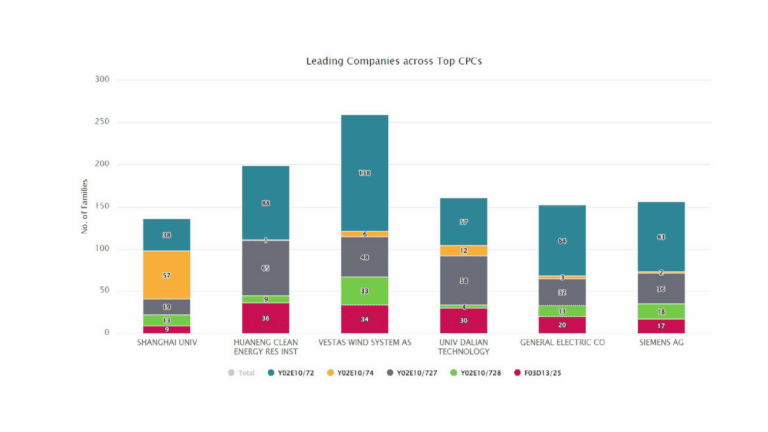Share
Share

Examining Key Players in Wind Turbine Technology: A Deep Dive into Patents and Progress
Over the years, wind turbine technology has seen significant evolution. Modern turbines employ advanced materials and intricate control systems to enhance efficiency and reliability. With a rising demand for clean energy sources for electricity generation, the wind turbine market is experiencing continuous growth. This market includes turbines for both onshore and offshore applications, and components such as blades, towers, nacelles, and generators.
To learn more about the technology approaches being used by key players in wind turbines, we conducted a quick analysis of their patenting trends across top CPC classes on PatSeer.

Here are the definitions of the classifications displayed above:
| CPC Classes | Class Definitions |
|---|---|
| Y02E10/72 | Wind turbines with rotation axis in wind direction |
| Y02E10/74 | Wind turbines with rotation axis perpendicular to the wind direction |
| Y02E10/727 | Offshore wind turbines |
| Y02E10/728 | Onshore wind turbines |
| F03D13/25 | Specially adapted for offshore installation |
Our key takeaways from the above chart:
- Analysis of the chart shows that Vestas Wind System AS has a notable number of filings under the Y02E10/72 classification, which focuses on efficient and cost-effective horizontal-axis wind turbines (HAWTs). They are closely followed by Huaneng Clean Energy Research Institute and Siemens AG.
- The graph also indicates that Vestas Wind System AS has filed a significant number of patents under the Y02E10/728 classification, which primarily covers on-shore wind turbines. These turbines represent a step forward in addressing climate change.
- In contrast to other key players, Shanghai University holds the highest number of patents under the Y02E10/74 classification, which relates to vertical-axis wind turbines (VAWTs). These may become the next industry trend due to their lower environmental impact and ease of installation.
- Additionally, Huaneng Clean Energy Research Institute and Dalian University of Technology appear to be focusing on the Y02E10/727 classification, which covers off-shore wind turbines. These turbines have the potential to deliver a more consistent and predictable electricity output.
- Furthermore, the graph indicates that Huaneng Clean Energy Research Institute has a strong presence in the F03D13/25 classification, which is designed for offshore installations. They are followed by Vestas Wind System AS and Dalian University of Technology.
In summary, based on the data from the graph, Vestas Wind System AS stands out as the leading company in wind turbine technology, having the most filings in the areas shown on the chart. Meanwhile, Huaneng Clean Energy Research Institute, Siemens AG, and General Electric Co. are other key players in this technological field.




